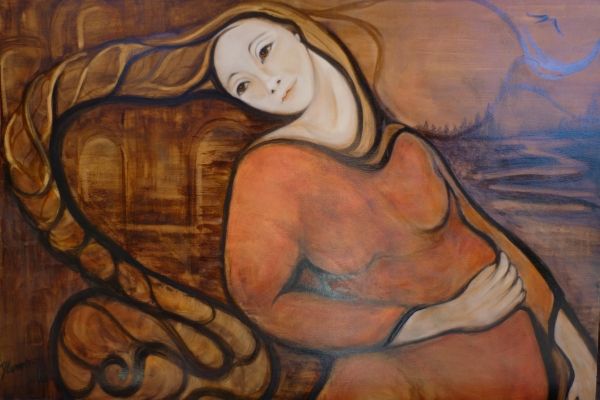~ Freedom is what we do with the choices available to us ~
Maiden-in-tower tales and folk traditions can be found throughout history and cultures, the themes of which often revolve around forbidden desires and locked doors, and freedom versus captivity. Today we’ll dive into one of the most famous maiden-in-tower tales, Rapunzel.
If you are reading this during 2020, then you’d know we’ve had quite the ride globally. We all had to be locked down in our own towers, though as humanity we’ve living in towers for long; towers built by our own conditioned human minds and limited understanding. I hear many people nowadays wanting to “erase” this year and even erase some parts of history, with censorships and changing textbooks’ content, etcetera; but I believe that it is important to remember our history as humanity, because when we erase or choose to forget, we will repeat the mistakes of the past. The story of Rapunzel was written during very important socio-economical times, and it was a tale written by revolutionary people who stood for human rights.
I am someone who’s always valued and treasured freedom. I’ve been fortunate enough to keep my mind free, my heart free, my spirit free. And when we do that, we are less likely to be manipulated or controlled, because we practice discernment, research on our own, keep learning and growing in our perceptions. Remaining independent in our minds and keeping our voice free are truly some of the best gifts we may give ourselves.
This is why I’ve always kept my website non-monetized, I keep creative control in all my work and books I’ve published, and I remain devoted to always learning, expanding, and practicing the beginner’s mind, approaching all with openness and curiosity. It’s so important for us as humanity to keep learning and remain open, and remaining flexible enough to expand beyond our own personal conditioned ideas, beliefs or perceptions.
When you approach life in the right way, it reveals itself to you. When you approach a word in the right way, a world reveals itself to you, and you enter a new way of learning and understanding. It’s good to read books or watch movies or browse art which you may have thought you wouldn’t like, and find out for yourself – perhaps you will see something you hadn’t seen before and come into some new learning or appreciation. Don’t limit yourself. The beginner’s mind is a Zen Buddhism concept for a reason; it is a path of spiritual expansion, creativity and freedom.
And today, we’ll talk about freedom also through the story of Rapunzel.
But what does freedom mean? What does it really mean to us? Are the walls internal or external?
The story of Rapunzel shows us very clearly that while the girl is the one in the tower, it is the witch who is the most imprisoned of them all, for she is bound to her bitterness, controlling tendencies and maliciousness.
When we can’t travel outside, we open the other doors – the inner ones. Because there’s no other way. We shift the souls of our feet towards exploring the familiar yet unknown landscapes of our inner world, where new insights may emerge and we’ll make a choice whether we’d allow them to inform us, and grow us.
When we are faced with external limits or walls is when we may choose to enrich our existence and truly expand. Through this inner expansion, we may become really rooted within the core of who we are, of our values, our morals and our being. Who we are matters now.
There is also something else that we learn when we are forced in our “towers”: we learn that we don’t know it all. With our limited understanding and conditioned human minds, we will never know it all, and the humility of this deserves to be treasured. By being grateful and humble, and trusting, the magic of life reveals itself to us, and we see how everything aligns perfectly just when we least expect it. And this means: we ultimately learn to trust ourselves and life itself in a way we couldn’t have otherwise if we knew it all.

Rapunzel by Trina Schart Hyman
Many people might see Rapunzel as a passive character – as a girl who is isolated and needs yet another prince to save her. This is not true.
She is in reality one of the most self-reliant storybook characters, who despite her limits and limitations, proved to be resourceful, brave and incredibly strong. It’s been long considered that the story of Rapunzel is one of the most important and rebellious tales written during its time, as it touches upon important social and moral issues, considered not just taboo but were even punishable.
Let’s go back to the beginning.
The term “fairytale” which is now used by the English speaking world as a generic label for magical children’s stories, was actually started by the literary salons of 17thcentury Paris by a group of writers who wrote and published tales for adult readers. As such, these tales often included themes that were dark, sexual, taboo, and even violent – to reflect the human condition and moral and socio-economical issues of society.

Rapunzel by Florence Harrison and Ernest Liebermann
The Italian tales by writers such as Giambattista Basile and Giovan Francesco Straparola, who wrote the original stories of Rapunzel, Cinderella, Sleeping Beauty and Snow White, were the inspiration for generations of writers in Paris.
The salons were gatherings hosted by prominent aristocratic women, where they discussed important issues of the day such as social issues of marriage, financial and physical independence, love, health and access to education. These were times of oppression and suppression, where divorce was unheard of, abuse was a daily reality, childbirth death was common, education was not given to most women and arranged marriages were the norm. Some of the most gifted women writers came to these salons, one of which was Charlotte-Rose de La Force.
La Force borrowed elements from the original Rapunzel called “Petrosinella” by Italian writer Giambattista Basile sixty years prior, and wrote her retold version, called Persinette, publishing it in her fairytale collection Les contes des contes in 1697. La Force was part of the group of writers who created adult fairytales in the literary salons of Paris, including the other writers, Charles Perrault, Madame D’Aulnoy and Madame de Murat.

Rapunzel by Trina Schart Hyman
Many people might see Rapunzel as some tale about a weak girl who plays a victim locked in a tower, waiting to be saved – and as such disempowering. But that’s not true. The tale of Rapunzel, told by both Basile and La Force, is actually very empowering telling the story of a young girl who was not weak at all. It is important to understand the essence of tales – and remember the history – so that we are more aware of just how important these voices were.
La Force, who was known as a very rebellious woman, wrote just like Basile, for an educated, aristocratic audience, that were meant to both entertain and bring awareness to contemporary life. One of the issues of that period was the common practice of arranged marriages, where daughters were used to cement alliances and settle debts; they were sold off. Sex was the husband’s legal right, whether or not the woman wanted it, consent was a mirage and rape was reality. And the disobedient daughters and women, were sent away in convents or locked up in madhouses. It is no wonder then, that French tales are filled with stories about girls handed off to wicked witches and creatures, by their cruel parents, or locked up in towers where only true love can save them.
La Force and other writers, fought hard to champion the idea of consensual marriages ruled by love and humanness. The emphasis on the themes of love and romance may seem silly today, but these stories were progressive, rebellious, meaningful and greatly important for their times. La Force herself was an independent thinker who came from a noble family and caused several scandals because she chose to live a life that was authentic and true to her heart.

Rapunzel by Paul O. Zelinsky
Behind The Scenes: Real life is stranger than fiction.
La Force fell in love with a man much younger than herself and attempted to marry him without parental permission. His family locked him away to prevent the marriage, and she snuck into his room dressed as a bear with a travelling theatre troupe. They escaped and married, until the law caught up to them and annulled the marriage. She then published satirical works criticizing King Louis XIV and when she got caught, was exiled to a convent to pay for the crime. Actually this is where she wrote her book of fairytales.
Rapunzel, or Persinette, is a sensual story with sly humour at its core. Rapunzel is a strong character, who showed herself to be quite resourceful when it came down to it and had the courage to run away following her awakened-in-desire heart. She even became a single mother (because the dude got dropped into some thorns, lost his sight and got lost) and looked after her children for a few years in some remote unknown place, faced with many hardships.
After the two lovers reunited, Gothel sent them famine and all other imaginary evil events, but they persevered, staying strong together. Perhaps Gothel’s heart finally showed signs of humanity and that’s why she sent them well on their way. Towards the prince’s castle, of course. I can only imagine Gothel lived a better, happier life after, since she decided to let go of the bitterness in her soul.

Rapunzel by Paul O. Zelinsky
Rapunzel lived almost her entire life locked between four walls, with limited contact, no education and no true affection. Despite her circumstances however, she showed herself as witty, clever, resourceful, clear-minded, self-reliant, courageous and very loving. All her imposed limitations had actually given her the opportunity to develop these within her. She couldn’t depend on anything external for happiness so she had to find her own entertainments and amusements. The sweet girl didn’t even know that she was pregnant because she didn’t know what “pregnant” meant. And yet suddenly, she was a single mother in the desert left all alone to give birth and care for herself and her two children, in the outside world; the one she’s never been in, the one that she was experiencing and seeing for the first time.
Rapunzel is not a passive character. When the time comes and she is faced with someone or something she truly wants, she is initiative and brave, as she is the one who plans the escape. And she never denied her true heart of love and kindness, despite Gothel’s jealous, possessive, controlling and evil ways.
There is a thing or two Rapunzel can teach us about the art of surrender. Fate doesn’t always come on our terms; it has its own timing. And often times, it requires passive acceptance and surrender. This doesn’t mean we don’t do anything with our lives – because we ourselves create our destiny by what depends on us, which is mainly our own hands, feet, mind and heart. There are times in life to lay low, other times we speak out; we choose our battles and learn the cycles of the land. But in the meantime, even if stuck in a room, we develop our character which ultimately guides our choices, and this creates our destiny.

She Wolfe Tarot
Rapunzel is one of the few tales written during its time, in which the strict notions of “morality” do not dictate who is rewarded and who is punished. Rapunzel wanders in the desert, alone, her hair taken away, and she is basically shuned from “society” after her illegitimate pregnancy is revealed. By all means, she is a “ruined and disgraced” woman because she has sex before marriage and becomes pregnant -and yet she is rewarded at the end of the tale when she is reunited with her prince and has her family complete.
Throughout the story we are shown examples of bad motherhood. The witch wanted to be a mother and yet once she was, she treated the child in the most horrible ways. When as a child Rapunzel started playing outside with the animals, feeding them and being so happy with them, Gothel became incredibly jealous and this is why she locked her in the tower. Gothel refused to let go of her control, possessiveness, insecurity and jealousy. Love is about acceptance; we can’t imprison others, manipulate them, control them or limit them, so that they love us. This is not love.
And then there’s Rapunzel. She never knew she could be a mother but once she was, she showed her love, devotion, trust, acceptance, strength and perseverance to care for her family. And she is the one who ends up with a loving family; one that she and her prince have built and will continue grow.
He shows his true love for her, not in a superficial way, but proven through time and felt only because of heart. He loves her despite her shorn hair and castaway status. She restores his sight with the warmth of her tears, and purity of heart. They fell in love in a weird way; unexpected, unconventional, scandalous, and spent their love nights sneaking up in a secret tower. They had children together. They suffered but found one another. Then suffered some more but continued to love one another. It’s a celebratory ending and possibly one of the most progressive and satisfying relationships of all fairytale narratives.

Rapunzel by Alix Berenzy
Do you know the story about the fish? Two fish friends are swimming the vast blue and come across a third one, “How’s the water, boys?” “It’s great,” they reply. After they swim away, and after some silence, the two friends look at each other and say, “What the hell is water?”
This is what happens to us. Rapunzel knows this because she learned this. She wouldn’t have known neither the outside world nor her inside world, unless she was faced with another perspective through which to see it and contrast it. Once she realized that there was something truer to her heart – she didn’t even hesitate to explore it.
There are many towers built either by us or by others: ego, the “I”, the narratives, the thought patterns, the cultural conditioning and all that we identify with. Our human body is a tower we always live in. Things like career, degree, status, money, partner, categories, checked boxes, colours, hobbies, and on and on and on – become extensions of our hands and legs and ears and mouths and even hearts. We become “it”.
For example, writing is what I do – it’s not who I am. The minute I stop writing this, I’ll just go back to being. Some walls are purposeful, some aren’t. Some are physical, most aren’t. This is why we need to be aware. And just like Rapunzel, once we wake up, may we all get out of the enchanted forests or towers built, which have become a prison. Once upon a time, we needed them for protection, for amusement, for resting, for safety or maybe someone else built them for us and we just didn’t know any better. May we have a heart that knows wisdom and discernment. When we find the true, we need to grab it. True love, true friend, true connections – these are so rare. Have the eyes to see it and fight for it because it’s worth it all. Have the courage to climb the walls and get your heart’s desire. Have the courage to believe and to the continue walking despite feeling like you can’t see the destination.
All human societies need to love and to be loved, and to connect with one another. This is how we can experience the full fierceness of human emotions, and only then, would we be able to understand the value of the sacred part of our life.

1909 illustration, artist unknown
What Rapunzel knows is love. She knows freedom of mind, freedom of spirit and freedom of heart. She knows that we are stronger than we think and we shouldn’t doubt how far we’ll go through thorns, mud and brick. She knows aloneness, she knows weakness, she knows fear, she knows loneliness, she knows uncertainty.
And she knows love.
And she knows that when she doesn’t know – she’ll trust her heart, and the souls of her feet and the souls of her hands will always know what to do. She knows that we carve our own destinies and that despite our circumstances we make a choice about the kind of person we want to be; that we can always look with eyes of love and hope and faith, and build a world beyond the walls.
She knows that sometimes we are locked in towers but that doesn’t mean we are robbed of freedom; we are meant to master that within the limitations, which is the power of our love and doing the best we can with what we have currently.
And one day, in a perhaps most unexpected and unconventional way, something or someone will speak or show up, and we’ll let down our hair. No matter where, no matter how, like rivers flow to sea, what is will always be.
Just be true to you. Stay true to you. Just like Rapunzel. Just like La Force. Just like all those who chose to live an authentic life, and whose voices we can still read sealed in time on old pages of old books – stories of love, stories of trust, stories of courage.

For more of my writings, browse through my Art of Love.
If you wish to support me and my work, you may do so by sharing it or donate here. For personal readings with me, you may visit my Offerings.
Your support means so much to me! Thank you wholeheartedly!
Cover Art: Rapunzel by artist Deann Cumner.




